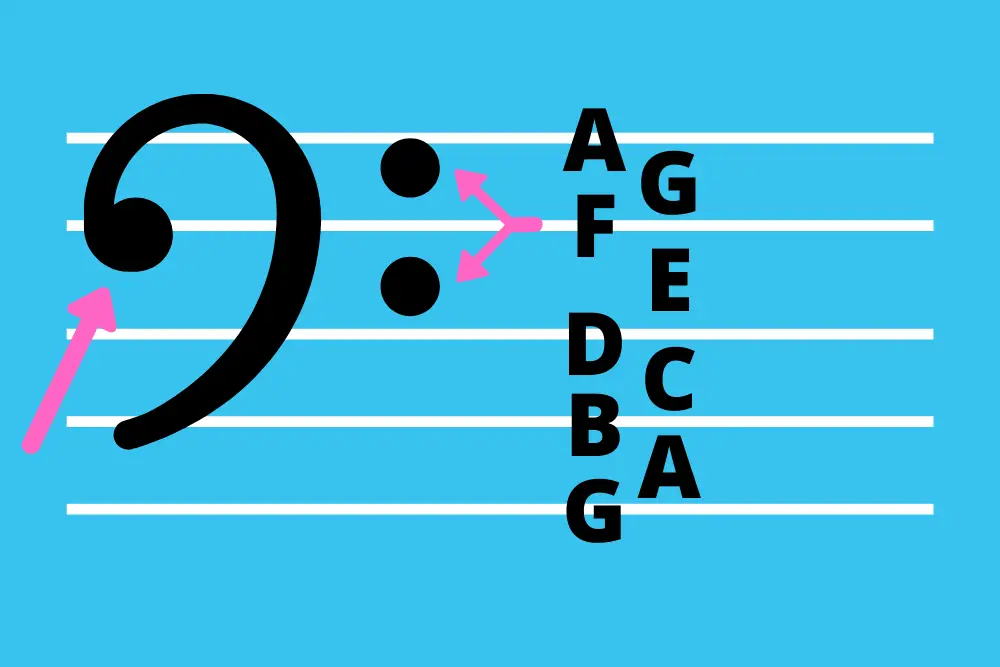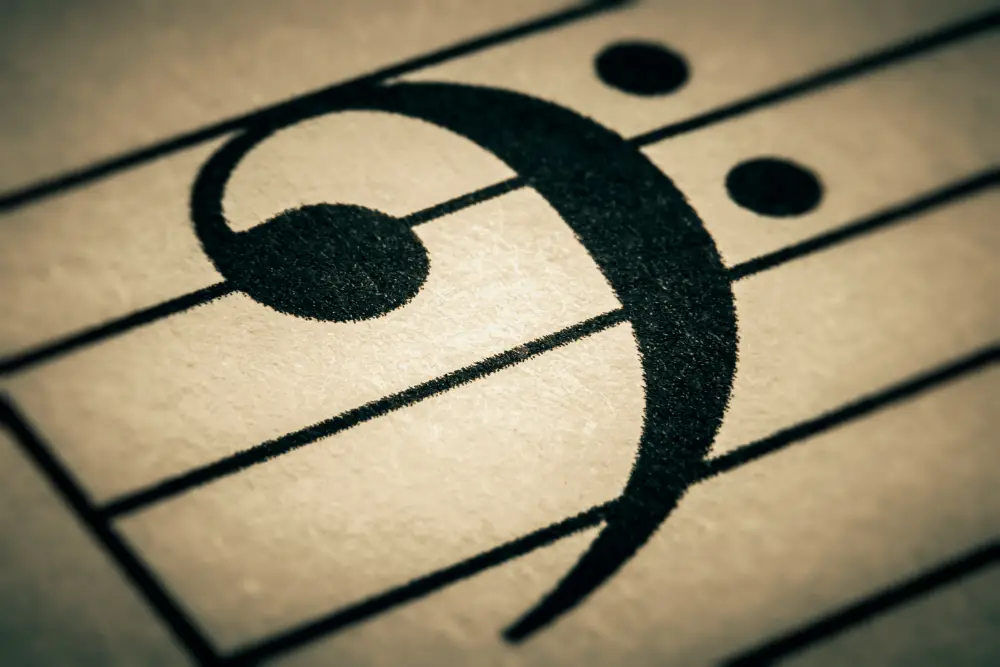Do you panic when you see bass clef?
Are you a fan of solfege but confused about how it relates to bass clef?
As a music teacher for over 10 years, I’ve seen the same situation occur with my oldest students over and over.
By the end of their time in elementary music, they’re experts in solfege and tackle treble clef with gusto.
But when I show them bass clef, they freeze up.
For those who learn solfege, they seem to learn bass clef faster than the rest, once they know where to start.
That’s why I wrote this short guide on solfege bass clef singing and reading.
Reading solfege in bass clef is just like reading any other time. Figure out where your Do or La is, and the rest fall into place in order. Do-Re-Mi-Fa-Sol-La-Ti.
Check out the rest of the post for more details on reading bass clef with solfege.
Table of Contents
What Is Bass Clef?
Bass clef, also known as F clef, is a way of reading lower pitches.
Clefs are ways to notate which letter notes get which lines and spaces.
Learn more about teaching treble clef note names.
The bass clef shows the lower notes.
The circle part of the graphic shows which note is F3 (see image).
Bass clef’s two dots also hover around the F3 line as well.
From there, it’s simple to figure out which notes are which by walking your way up and down.

Solfege For Bass Clef
To sing in solfege with bass clef is exactly like singing in treble clef.
First, find your starting note in the correct key.
It’s easiest to find Do even if you’re singing in minor.
Check out how to sing solfege in minor scales.
From Do, you walk your way up and down the solfege scale.
Going up is Do, Re, Mi, Fa, Sol, La, and Ti.
Repeating more goes back to Do and starts over.
Going down from Do goes like Do, Ti, La, Sol, Fa, Mi, and Re.
As always, when you run out of new notes, you start over.
3 Ways To Figure Out Where “Do” Is In Bass Clef
1. If there are no sharps and flats, Do is C.
2. If there are sharps, the note above the last sharp is Do.
For example, if there are two sharps, the last one will be C#.
This means the note above (D) is Do.
3. There are flats, the second to last flat is Do.
For example, if there are 2 flats (Bb and Eb), the second-to-last one is Do.
In this case, Bb is second to last, and Bb is Do.
The exception is when there is only one flat.
In this case, F is Do.
You may also want to learn about solfege sharps and flats.
What Are The Sayings For Bass Clef?
Everyone has heard of the treble clefs sayings for the lines and spaces.
Are there ones for bass clef?
For sure!
They aren’t as well known, but there is plenty to use.
The line notes from bottom to top are G, B, D, F, and A.
The common saying is:
Good Boys Do Fine Always.
The space notes are A, C, E, and G.
A common phrase is:
All Cows Eat Grass.
These ones are a little boring.
My students once came up with a couple of good ones.
George Bush Dances Funny Always.
Alligators Crunch Every Grape.
Why Is Bass Clef Solfege Helpful?
The strengths of solfege apply in bass clef too.
If you’re familiar with singing solfege and how the sounds of the pitches work together, you don’t need to immediately know all the specific letter names in bass clef.
Just figure out where you start and go from there.
You don’t even have to look at the clef.
If you’re playing instruments, the solfege will help you fit the notes together without being focused on the exact letters.
Good training in solfege helps the music flow without getting caught up in the reading parts.
Is Bass Clef High Or Low?
Bass clef is the low clef.
The top line is A3.
The bottom line is G2.
Let’s compare this with the other common clef, treble clef.
Treble clef’s lowest line is E4.
Its highest line is F5.
Common treble instruments are:
- Flute
- Trumpet
- Clarinet
- French horn
- Violin
- Most female voices
- Children’s voices
Common bass clef instruments:
- Trombone
- Euphonium
- Bass clarinet
- Cello
- String bass
- Most male voices
What Is G Clef And F Clef?
G clef is the nickname for treble clef.
The “swirly” part of the treble clef goes around the second line from the bottom, which is G.
Some people say the treble clef also looks like a G, but I’ve never seen that.
F clef, as we mentioned above, is the nickname for bass clef.
The initial dot (look at the graphic above) points out the third line from the bottom, which is F.
Did The Clefs Always Focus On These Lines?
No.
The position of the clefs moved to allow different instruments to read.
In the modern-day, the clefs have stayed largely the same.
There’s also the Alto and Tenor clefs.
These are much less well-known, but they do appear.
These clefs show an example of the idea I was just talking about.
The symbols are the same, and the only difference in the clef is the position.
The standardization of the pitch in the 1700s took much of this variety away.
By the early 1900s, shifting clefs disappeared.
Final Thoughts
I hope this short guide on solfege with bass clef helps you get started without many problems.
It seems hard at first, but as with most things, it just takes some practice.
Find your starting note using the 3 tricks and figuring out which letters go on which lines and spaces.
That note is Do, and you go from there.
To further improve your skills, check out these 8 solfege exercises.

